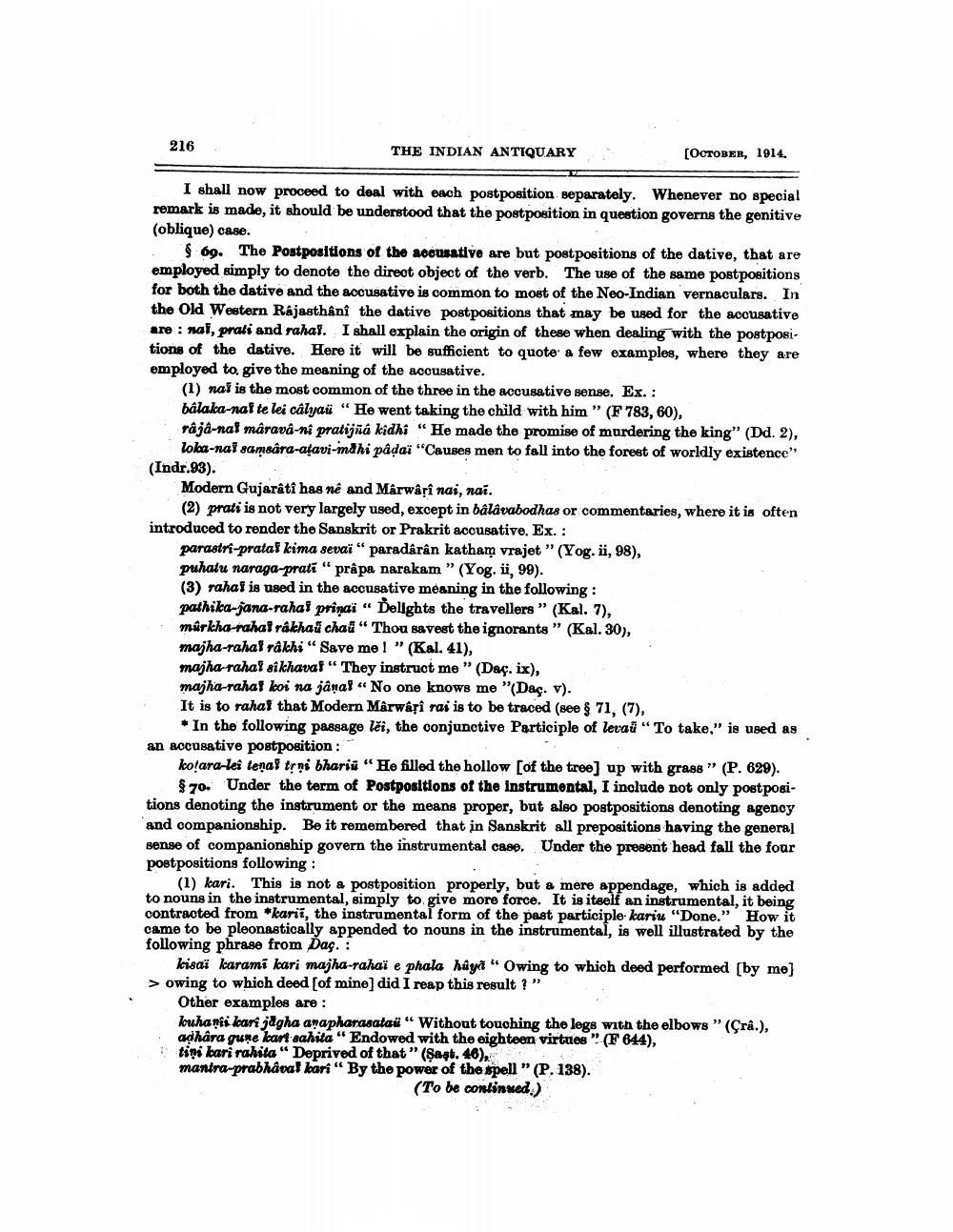________________
216
THE INDIAN ANTIQUARY
[OCTOBER, 1914.
=
I shall now proceed to deal with each postposition separately. Whenever no special remark is made, it should be understood that the postposition in question governs the genitive (oblique) case.
$ 60. The Postpositions of the accusative are but postpositions of the dative, that are employed simply to denote the direct object of the verb. The use of the same postpositions for both the dative and the accusative is common to most of the Neo-Indian vernaculars. In the Old Western Rajasthani the dative postpositions that may be used for the accusative are : nal, prati and rahal. I shall explain the origin of these when dealing with the postpositions of the dative. Here it will be sufficient to quote' a few examples, where they are employed to give the meaning of the accusative.
(1) nal is the most common of the three in the accusative sense. Ex.: balaka-naf te lei câlyaü "He went taking the child with him " (F 783, 60), raja-nat mârava-ni pratijjá kidhi "He made the promise of murdering the king” (Dd. 2),
lola-naf samsara-atavi-mahi padai “Causes men to fall into the forest of worldly existence" (Indr.93). .
Modern Gujarati has né and Marwari nai, nai.
(2) prati is not very largely used, except in bálavabodhas or commentaries, where it is often introduced to render the Sanskrit or Prakrit accusative. Ex.:
parastri-pratal kima sevai" paradârân katham vrajet " (Yog.ii, 98), puhatu naraga-prati" prâpa narakam" (Yog. ii. 99). (3) rahat is used in the accusative meaning in the following: pathika-jana-rahal prinai " Delights the travellers" (Kal. 7), mürkha-rahal rakhai chau“ Thou savest the ignorants " (Kal. 30), majha-rahal rakhi “ Save me!" (Kal. 41), majha-rahal sikhaval" They instruct me" (Dac. ix), majha-rahal koi na janal “No one knows me "(Dac. v). It is to rahal that Modern Mârwarî rai is to be traced (see $ 71, (7),
• In the following passage lči, the conjunctive Participle of levad "To take," is used as an accusative postposition :
kotara-lei tenai trni bhariü “He filled the hollow [of the tree) up with grass " (P. 629).
$70. Under the term of Postpositions of the instrumental, I includo not only postpositions denoting the instrument or the means proper, but also postpositions denoting agency and companionship. Be it remembered that in Sanskrit all prepositions having the general sense of companionship govern the instrumental case. Under the present head fall the four postpositions following:
(1) kari. This is not a postposition properly, but a mere appendage, which is added to nouns in the instrumental, simply to give more force. It is itself an instrumental, it being contracted from *karii, the instrumental form of the past participle- kariu "Done." How it came to be pleonastically appended to nouns in the instrumental, is well illustrated by the following phrase from Daç. :
kisaż karami kari majha-rahaï e phala haya " Owing to which deed performed by me) > owing to which deed (of mine) did I reap this result ?"
Other examples are : louha nii kart idgha anapharasataü " Without touching the legs with the elbows" (Crâ.), adhara gune kart sahita “Endowed with the eighteen virtues" (F 644), tini kari rahita “Deprived of that " (Sazt. 46), mantra-prabhaval kari" By the power of the spell " (P. 138).
(To be continued.)




